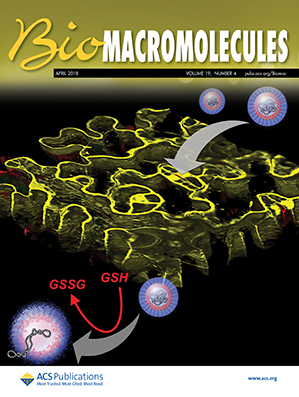Balancing Permeability and Stability: A Study of Hybrid Membranes for Synthetic Cells Using Lipids and PBd‑b‑PEO Block Copolymers
IF 5.4
2区 化学
Q1 BIOCHEMISTRY & MOLECULAR BIOLOGY
引用次数: 0
Abstract
We have synthesized hybrid membranes composed of amphiphilic block copolymers, polybutadiene–poly(ethylene oxide) [PBd-b-PEO], with different lengths [PBd22-PEO14 and PBd11-PEO8] and mixtures of phospholipids (DOPC:DOPG:DOPE 50:25:25 mol %) to combine the properties of both in terms of stability and fluidity of the membrane. The amphiphilic block copolymers increase the stability, whereas the lipids support the functionality of membrane proteins. The hybrid nature of the bilayers was studied by means of Cryo-TEM, Langmuir–Blodgett technique, atomic force microscopy (AFM), electrical measurements, and fluorescence-based stopped-flow assay to determine the permeability of the membrane for water and osmolytes. We observe that the structural, thermodynamic, and permeability properties of hybrid PBd11-PEO8 membranes are similar to their purely lipid counterparts, with the advantage of being more stable and resisting a higher transmembrane electrical potential. Hybrid membranes with the longer polymer, PBd22-PEO14, display more significant structural, thermodynamic, and permeability differences and show less favorable properties than hybrid-PBd11-PEO8 membranes.
- Download: Download high-res image (103KB)
- Download: Download full-size image
平衡渗透性和稳定性:脂质和PBd-b-PEO嵌段共聚物合成细胞杂化膜的研究。
我们合成了两亲嵌段共聚物聚丁二烯-聚环氧乙烷[PBd-b-PEO],不同长度[PBd22-PEO14和PBd11-PEO8]和磷脂混合物(DOPC:DOPG:DOPE 50:25:25 mol %)组成的杂化膜,以结合两者在膜的稳定性和流动性方面的性能。两亲嵌段共聚物增加了稳定性,而脂质支持膜蛋白的功能。通过低温透射电镜(cro - tem)、Langmuir-Blodgett技术、原子力显微镜(AFM)、电测量和基于荧光的止流分析来研究双层膜的杂化性质,以确定膜对水和渗透物的渗透性。我们观察到,杂化PBd11-PEO8膜的结构、热力学和渗透性与纯脂质膜相似,具有更稳定和抵抗更高跨膜电位的优势。与pbd11 - peo8相比,具有较长聚合物PBd22-PEO14的杂化膜在结构、热力学和渗透性方面表现出更大的差异,但性能却不如杂化膜。
本文章由计算机程序翻译,如有差异,请以英文原文为准。
求助全文
约1分钟内获得全文
求助全文
来源期刊

Biomacromolecules
化学-高分子科学
CiteScore
10.60
自引率
4.80%
发文量
417
审稿时长
1.6 months
期刊介绍:
Biomacromolecules is a leading forum for the dissemination of cutting-edge research at the interface of polymer science and biology. Submissions to Biomacromolecules should contain strong elements of innovation in terms of macromolecular design, synthesis and characterization, or in the application of polymer materials to biology and medicine.
Topics covered by Biomacromolecules include, but are not exclusively limited to: sustainable polymers, polymers based on natural and renewable resources, degradable polymers, polymer conjugates, polymeric drugs, polymers in biocatalysis, biomacromolecular assembly, biomimetic polymers, polymer-biomineral hybrids, biomimetic-polymer processing, polymer recycling, bioactive polymer surfaces, original polymer design for biomedical applications such as immunotherapy, drug delivery, gene delivery, antimicrobial applications, diagnostic imaging and biosensing, polymers in tissue engineering and regenerative medicine, polymeric scaffolds and hydrogels for cell culture and delivery.
 求助内容:
求助内容: 应助结果提醒方式:
应助结果提醒方式:


